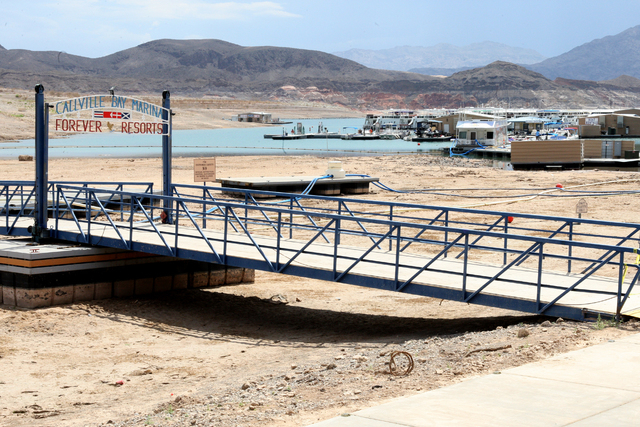Lake Mead to get more water

Lake Mead will get more water from its upstream neighbor in the coming year, but not enough to halt its decline, according to new U.S. Bureau of Reclamation projections.
Lake Powell is now expected to release 8.23 million acre-feet of water downstream to Mead during the next federal water year, which runs Oct. 1 through Sept. 30. That’s 750,000 acre-feet more than this year’s delivery.
But the extra water will only slow the reservoir’s descent, not reverse it. The reason is simple: The amount of water flowing into Lake Mead is less than the amount flowing out each year to supply farms and cities in Nevada, Arizona, California and Mexico.
Water users on the lower Colorado River are expected to receive their full orders again next year, even though the surface of the lake now sits at about 1,080 feet above sea level, its lowest point since first being filled in 1937.
Nevada is allowed to use 300,000 acre-feet of Colorado River water each year, the smallest share by far among the seven Western states that draw from the river. Nearly all of Nevada’s allocation goes to the Las Vegas Valley, which gets roughly 90 percent of its water supply from Lake Mead.
One acre-foot of water is enough to supply two average valley households for a little over one year.
The complicated federal framework that decides the coordinated rise and fall of the nation’s two largest man-made reservoirs was implemented in late 2007, and is designed to assure minimum water levels in lakes Mead and Powell through 2026.
The current 7.48 million acre-foot delivery to Lake Mead was the smallest release since Glen Canyon Dam was built and Lake Powell was first filled in the 1960s. As a result of the 8.23 million acre-foot release now scheduled for the coming year, the Bureau of Reclamation raised its Lake Mead projections by at least a foot each each month through July 2016, but the overall downward trend continues.
Rose Davis, spokeswoman for the bureau’s regional office in Boulder City, said she’s just glad to see Lake Mead “avoid another record-low release.”
The level of both lakes is way down as a result of a record 15-year dry spell across the region drained by the over-appropriated Colorado River. This year’s mountain snow runoff was about 94 percent of average, but it came on the heels of two straight years that saw the Colorado receive less than half its normal flow.
The bureau bases its annual delivery between Powell and Mead on the August version of its monthly operational study, which predicts reservoir conditions over the next two years. That report came out Wednesday.
Conditions at the two reservoirs will be reviewed again in April to determine if the release can be increased to 9 million acre-feet.
Despite the record low levels, the lake is expected to stay just above the point that would trigger the first-ever federal shortage declaration on the Colorado River next year and prompt both Arizona and Nevada to cut water deliveries.
Based on Wednesday’s report, federal forecasters expect Lake Mead to narrowly avoid that all-important shortage line in 2016 as well, though the accuracy of such projections diminishes the further out you go, especially when Mother Nature is involved.
As Davis put it: “Well, we’ll see about that.”
Contact Henry Brean at hbrean@reviewjournal.com or 702-383-0350. Follow @RefriedBrean on Twitter.